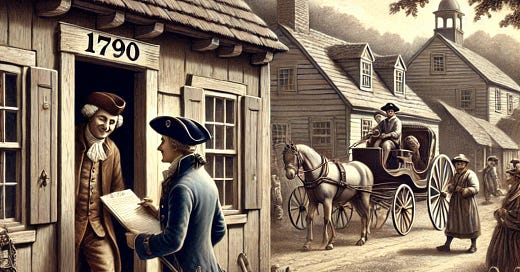On this day in 1790, the newly formed United States took a monumental step in understanding its demographics. As mandated by Article 1, Section 2, of the Constitution, the first census was carried out. It was a massive endeavor to count every individual in the country, a task assigned to the marshals of the United States judicial districts.
Imagine the scene—census takers traveling from house to house, collecting data in a young nation with poor transportation links and a widely dispersed population. The final tally revealed a population of 3,929,214 inhabitants. This figure included 697,624 enslaved individuals, highlighting the stark reality of slavery in the early United States.
Despite the effort, key figures of the time, including President George Washington and Secretary of State Thomas Jefferson, were skeptical of the results. They suspected that the true population might have been undercounted. Reasons for this possible undercount could include the vast, sparsely populated landscape, rudimentary transportation, and the limitations of contemporary technology. Some individuals might have even refused to participate.
The census form was simple but revealing. It listed the name of the head of each household and counted free white males over 16, free white males under 16, free white females, all other free persons, and enslaved individuals. This data provided a snapshot of the nation's demographics and set a precedent for future censuses.
Unfortunately, not all the records from the 1790 census survived. The data from several states, including Delaware, Georgia, New Jersey, and Virginia, were lost between 1790 and 1830. Almost one-third of the original census data have been lost or destroyed since their original documentation. Despite these losses, the census remains a crucial historical document.
The census covered all thirteen original states and the Southwest Territory. Interestingly, Vermont, which was an independent republic until 1791, was not included in the census until after it joined the Union as the 14th state.
One striking statistic from the 1790 census was that 17.8% of the population was enslaved, the highest proportion ever recorded in U.S. census history. This figure starkly reminds us of the deep-rooted issues of slavery that the nation would struggle with for decades to come.
The 1790 census was more than just a population count; it was a foundational step in the governance and understanding of a new nation. It set the stage for how we collect and use demographic data, impacting everything from political representation to resource allocation. This first census laid the groundwork for the decennial tradition that continues to this day, influencing the distribution of seats in the House of Representatives and the allocation of federal funds.
The method of collecting data was labor-intensive and required marshals to visit every household. The law required that every household be visited, that completed census schedules be posted in 'two of the most public places within [each jurisdiction], there to remain for the inspection of all concerned...' and that 'the aggregate amount of each description of persons' for every district be transmitted to the president. Despite these efforts, the challenges of reaching remote areas and encouraging participation were significant.
The data collected provided invaluable insights. Column titles on the census form included the name of the head of the family, the number of free white males aged 16 and over, the number of free white males under 16, the number of free white females, the number of all other free persons, and the number of enslaved individuals. This structured approach allowed the government to understand the population distribution and the socio-economic conditions of the time.
The records for several states were lost over time, but secondary sources confirm the validity and existence of much of the data. No microdata from the 1790 population census are available, but aggregate data for small areas, together with compatible cartographic boundary files, can be downloaded from the National Historical Geographic Information System.
Under the direction of Secretary of State Thomas Jefferson, marshals collected data from all thirteen states and the Southwest Territory. The census was not conducted in Vermont until 1791, after it became the 14th state. At 17.8 percent, the 1790 census's proportion of enslaved individuals to the free population was the highest ever recorded by any census of the United States. This statistic highlights the early nation's dependence on enslaved labor and foreshadows the intense struggles that would eventually lead to the Civil War.
The process and outcome of the 1790 census are a testament to the young nation's commitment to self-knowledge and governance. It provided a critical foundation for future censuses and demonstrated the importance of accurate data collection in shaping national policies. The lessons learned from the 1790 census continue to inform how we conduct and use census data today.
The 1790 census was a pioneering effort that set the stage for a tradition that continues to be vital to our democracy. It was a crucial step in understanding the demographics of the new nation and laid the groundwork for informed decision-making at the highest levels of government.













Share this post